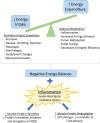Cancer cachexia: Pathophysiology and association with cancer-related pain
- PMID: 36072367
- PMCID: PMC9441771
- DOI: 10.3389/fpain.2022.971295
Cancer cachexia: Pathophysiology and association with cancer-related pain
Abstract
Cachexia is a syndrome of unintentional body weight loss and muscle wasting occurring in 30% of all cancer patients. Patients with cancers most commonly leading to brain metastases have a risk for cachexia development between 20 and 80%. Cachexia causes severe weakness and fatigue and negatively impacts quality and length of life. The negative energy balance in cachectic patients is most often caused by a combination of increased energy expenditure and decreased energy intake. Basal metabolic rate may be elevated due to tumor secreted factors and a systemic inflammatory response leading to inefficiency in energy production pathways and increased energy demand by the tumor and host tissues. A growing body of research explores physiological and molecular mechanisms of metabolic dysregulation in cachexia. However, decreased energy intake and physical functioning also remain important contributors to cachexia pathogenesis. Pain associated with metastatic malignancy is significantly associated with inflammation, thus making inflammation a common link between cancer pain and cachexia. Pain may also influence appetite and food intake and exacerbate fatigue and functional decline, potentially contributing to cachexia severity. Cancer pain and cachexia often occur simultaneously; however, causal relationships remain to be established. Appropriate assessment and treatment of pain in advanced cancer patients may positively impact nutrition status and physical functioning, slowing the progression of cachexia and improving quality and length of life for patients.
Keywords: anorexia; cachexia; cancer; fatigue; inflammation; muscle atrophy; nutrition impact symptoms; pain.
Copyright © 2022 Law.
Conflict of interest statement
The author declares that the research was conducted in the absence of any commercial or financial relationships that could be construed as a potential conflict of interest.
Figures


References
Publication types
LinkOut - more resources
Full Text Sources

